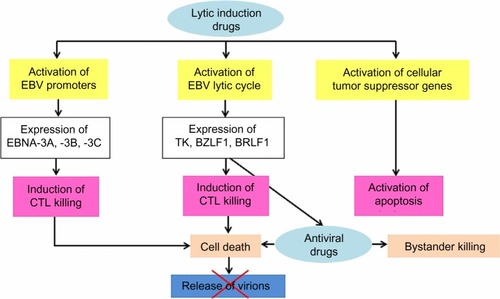Figures & data
Figure 1 Schematic concept of treatment in NPC targeting EBV using a combination of lytic inducing regimens and antiviral drugs.
Notes: Lytic inducing drugs cause an effect in three mechanisms. They activate EBV promoters that lead to transcription of immunodominant latent and lytic gene products. Expression of the highly immunogenic lytic viral proteins such as EBNA3s will evoke the immune system and subsequent CTL elimination, thus inhibiting release of new virions. Antiviral treatment that is administered at an early lytic stage is converted into a cytotoxic drug by viral kinases and induce susceptibility of EBV-carrying tumor cells to CTL killing. Reexpression of host tumor suppressor genes may promote apoptosis of the EBV-infected cells. The simultaneous processes will result in tumor debulking.
Abbreviations: CTL, cytotoxic T-cells; EBV, Epstein–Barr virus; NPC, nasopharyngeal carcinoma; TK, thymidine kinase.
Abbreviations: CTL, cytotoxic T-cells; EBV, Epstein–Barr virus; NPC, nasopharyngeal carcinoma; TK, thymidine kinase.

